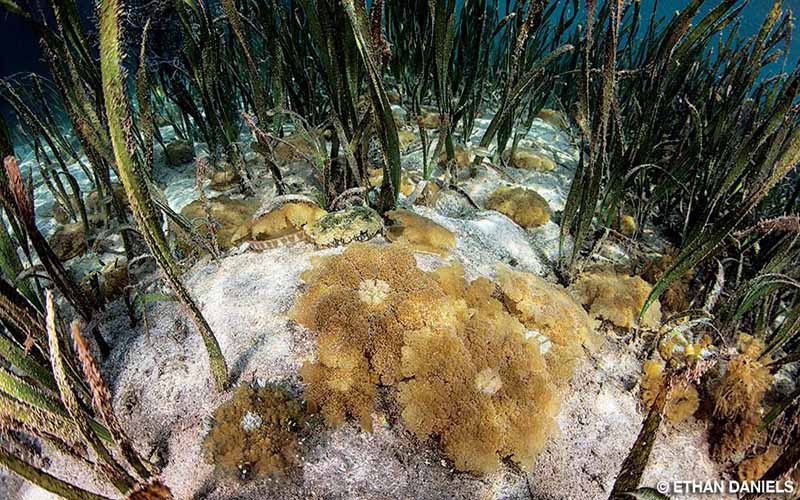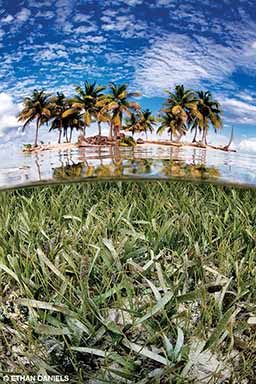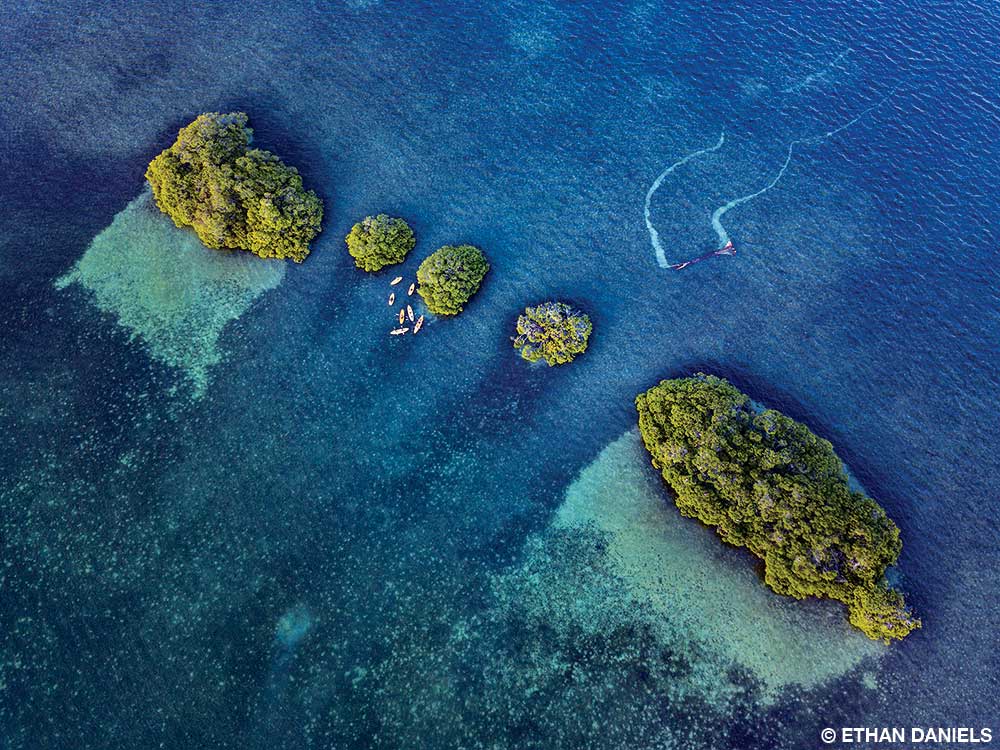Although Walt Whitman was not writing about seagrass, I still admire his words: “I believe a leaf of grass is no less than the journey-work of the stars.” While I have committed my life to the study and exploration of the sea and its faunal inhabitants, I still find something indefinably exquisite about primary producers, which are largely disregarded among the diving and snorkeling community. Tidal, typically unphotogenic and seemingly monotonous, seagrasses are low on the totem pole of habitat popularity — though the hundreds of millions of people who live in coastal areas and depend on the oceans’ resources greatly appreciate them.

There are numerous examples of species that evolved on land and then — for one reason or another, such as the endless battle for resources and survival — modified themselves through natural selection to succeed in the aquatic world. While most people think of marine mammals when considering such evolution, plants — namely seagrasses, which are flowering plants with seeds, roots, stems and leaves — have also migrated from terrestrial ecosystems and adapted to shallow, salty or brackish habitats at least three different times over the past 100 million years. In both tropical and temperate regions, about 72 species of seagrass grow in aquatic meadows around the world.
My first exposure to underwater plants came early, when growing up on the coastal waters of Cape Cod, Massachusetts, where eelgrass (Zostera marina) dominated the seafloor. Temperate eelgrass beds where I first snorkeled were full of life once I became patient enough to notice. These initial, revelatory experiences almost certainly led to my lifelong interest in biology.
Years later I jumped at the opportunity to work in the Republic of Palau, where the same type of underwater experiences abounded. Along the east coast of Palau’s largest island, Babeldaob, widespread meadows of seagrass flourished from the edge of the land out to the reef crest hundreds of yards away. Back then I knew seagrasses were monocotyledons (flowering plants whose seeds have one embryonic leaf) distantly related to lilies and palms, but I was just beginning to recognize what roles seagrasses played in the overall marine ecosystem.
A deeper understanding of the plants’ significance became evident when Palauan fishermen showed me how much renewable food was sourced from seagrass beds. Sea cucumbers, urchins, clams, crabs and fish were all commonly gleaned from or fished for in this area. A healthy seagrass bed could indefinitely provide for a village.

Seagrasses contribute more than just edible resources. Similar to mangrove forests, seagrasses in nutrient-rich areas slow currents and allow terrestrial sediment runoff to filter out of the water. In nutrient-poor areas, seagrasses can absorb nutrients from the soil and release them through their leaves, thereby acting as a nutrient pump. Their underground roots and rhizomes (thick horizontal stems) effectively stabilize the sandy seafloor, minimizing soil erosion and buffering coastlines. In turn, nearby corals and associated reef organisms tend to thrive in the clear, sediment-reduced water flowing out of the seagrass during outgoing tides.
On a more global scale, the planet’s seagrass beds capture enormous amounts of atmospheric carbon, which is essential to slowing the rate of climate change. Scientists estimate that Earth’s seagrasses capture up to 83 million metric tons of carbon per year as primary producers and by utilizing organic carbon in their leaves and roots. Chloroplasts in the plant tissues convert carbon dioxide and water into oxygen and sugars with the help of energy from the sun. One square meter of seagrass can generate 10 liters of oxygen each day through photosynthesis. As seagrasses die and decompose, their organic carbon is stored in the soil. Recent research conducted by Florida International University scientists, however, has shown the capacity of seagrass beds to store carbon varies from region to region depending on the biodiversity found within the local habitat.

Seagrasses typically create a highly suitable environment for a wide array of creatures, including humans. Seagrass beds, where competition and predation are not nearly as intense as on coral reefs, are ideal nurseries. They provide shelter and food for small invertebrates and fish. Similar to the dominant trees in a rainforest, seagrass blades act as a home for many epiphytic (growing on plant surfaces) species of algae, bacteria, bryozoans and other invertebrates. Nestled on the seafloor amid the sinuous blades of grass are sponges, worms, anemones and a variety of echinoderms. Octopus, squid, cuttlefish and gastropods as well as countless crustaceans make this green habitat their home.
Scientists have calculated that one acre of healthy seagrass can sustain almost 40,000 fish and tens of millions of small invertebrates. With all the primary production and accumulated biodiversity, seagrass beds are observably valuable feeding grounds for stingrays and some of the world’s most endangered marine mammals such as dugongs and their close relatives, manatees, as well as endangered reptiles such as green sea turtles.
Humans should not be in a situation where they are guarding the delicate vestiges of what once existed, but unfortunately seagrasses are seriously threatened across the globe. Seagrass beds are being destroyed at a rate of 1.5 percent annually — mainly due to human activities — which directly affects local and global marine biodiversity. With no international security and extremely limited local protection, seagrass meadows are at a high risk from dredging, runoff pollutants and nutrification, land reclamation and overfishing.
While some communities concerned about food security have put effort into restoring local seagrass beds, it is a drop in the bucket compared to those being eliminated. Undoubtedly, the principal problem facing seagrass beds, as well as every other ecosystem on Earth, is human overpopulation, which contributes to all of the concerns delineated above and is not an easily solved issue. Declining seagrass beds spells trouble for many species as well as people. More climatic changes such as rising seas, reshaped coastlines, ocean acidification and warmer water are to come, making it difficult to predict what the future holds for this type of habitat.
It is remarkable how multifarious our planet is, and that diversity is one of the most inspiring aspects of life. The Earth’s numerous environments, including seagrass beds, continually transform. They are robust in some ways and fragile in others. In time they expand, contract, adapt to new conditions or disappear. Seagrass habitats are highly nuanced and complex. By studying the details of seagrass genomes, scientists are seeking to discover how seagrasses originally adapted to the salty, underwater ocean environment, how they are currently responding to climatic stresses and how their salt tolerance could be used to assist human crops grown in low-lying areas susceptible to sea-level rise.

As I have learned more about seagrass beds over time, I have developed more of a bond and become more protective of them, like my feelings toward other underwater habitats. It seems to be human nature to change and modify our surroundings, but in many cases, especially with seagrass communities, that habit is certainly deleterious. The ecosystem benefits from being undisturbed; the overall welfare of seagrass beds and associated marine habitats should unquestionably be a larger consideration for local and international communities. Everything is connected, and yet many modern conservation and management methods are not treating ecosystems in this manner.
Seagrasses are truly incredible life forms, made of organic compounds and producing their own food, that have significantly contributed to making our planet inhabitable. Intimately tied to coral reefs and mangroves, seagrass beds are accessible natural laboratories of extravagant yet veiled life. With time will come greater appreciation of the amazing underwater flowering plants and the many marine denizens that utilize them to create a flourishing habitat. Perhaps more divers and snorkelers like me will get out there and patiently explore and uncover more secrets of the “journey-work of the stars.”
| © Alert Diver — Q4 2018 |